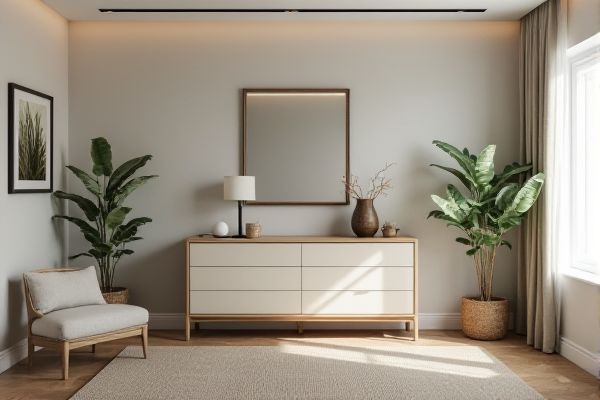
A built-in dresser offers a seamless, space-saving solution that integrates directly into your room's architecture, while a freestanding dresser provides flexibility and easy relocation to suit changing needs. Discover which option best fits Your style and functionality requirements by reading the rest of the article.
Table of Comparison
| Feature | Built-in Dresser | Freestanding Dresser |
|---|---|---|
| Installation | Permanent, integrated into wall or closet | Movable, no installation required |
| Customization | Highly customizable to space and design | Limited to available sizes and styles |
| Space Efficiency | Optimizes space, fits perfectly in niche | Requires floor space, less efficient |
| Durability | Usually built with solid materials, sturdy | Varies by materials, can be less durable |
| Cost | Higher initial cost due to custom work | Generally more affordable upfront |
| Mobility | Fixed, not movable | Portable, easy to relocate |
| Resale Value | Increases home value, permanent fixture | Little impact on home resale value |
| Design Flexibility | Seamless integration with room design | Limited to design trends and trends change |
Introduction to Built-in and Freestanding Dressers
Built-in dressers integrate seamlessly into your room's architecture, offering customized storage solutions that maximize space efficiency and add lasting value to your home. Freestanding dressers provide flexible, movable storage options that can be easily updated or relocated to suit changing design preferences. Choosing between built-in and freestanding dressers depends on your spatial needs, style preferences, and long-term functionality goals.
Key Differences Between Built-in and Freestanding Dressers
Built-in dressers are integrated into the walls, offering custom dimensions that maximize space efficiency and provide a seamless appearance, while freestanding dressers offer portability and flexibility in placement. Built-in options typically require professional installation and are permanent fixtures, whereas freestanding dressers can be moved easily and replaced without alterations to the room. Material choices for built-in dressers often match existing cabinetry, enhancing room cohesion, whereas freestanding dressers come in diverse styles and finishes suited to varying decor tastes.
Space Optimization: Which Dresser Fits Your Room?
Built-in dressers maximize space by utilizing wall recesses and custom dimensions, ideal for small or irregularly shaped rooms where floor area is limited. Freestanding dressers offer flexibility and mobility, allowing easy rearrangement and adaptability in various room layouts. Choosing between built-in and freestanding dressers depends on available room dimensions, design preferences, and the need for permanent versus versatile storage solutions.
Customization Options and Design Flexibility
Built-in dressers offer extensive customization options, allowing integration with existing architectural elements and tailored dimensions to maximize space efficiency. Freestanding dressers provide greater design flexibility with a broad variety of styles, finishes, and portability, enabling easy room reconfiguration. Choosing between the two depends on whether seamless integration or adaptable aesthetics is the primary priority.
Installation Process: Built-in vs Freestanding
The installation process for built-in dressers involves precise measurements, customization, and professional carpentry work to fit seamlessly into designated wall spaces, often requiring wall reinforcement and permanent attachment. Freestanding dressers offer a straightforward setup with minimal assembly, allowing easy relocation and no special installation tools or modifications to the room structure. Built-in dressers demand longer installation time and expert handling, while freestanding dressers are more convenient for quick placement and mobility.
Storage Capacity and Organizational Features
Built-in dressers maximize storage capacity by utilizing wall space efficiently, often including custom compartments, shelves, and integrated lighting to enhance organization. Freestanding dressers offer flexible placement but usually provide limited compartmentalization and storage space compared to built-ins. Customizable built-in units often feature specialized drawer dividers and hidden storage options, optimizing organization for specific needs.
Durability and Longevity Comparison
Built-in dressers generally offer enhanced durability due to their integration with wall structures, providing greater stability and resistance to wear over time compared to freestanding dressers. Freestanding dressers, though more susceptible to damage from movement and less anchored support, often allow for easier repairs or replacements of individual components. Investing in high-quality materials and construction methods significantly affects the longevity of both types, but built-in models typically outperform freestanding options in maintaining structural integrity over decades.
Aesthetic Appeal and Interior Design Impact
Built-in dressers seamlessly integrate with your room's architecture, offering a sleek, customized look that enhances overall aesthetic appeal and maximizes space efficiency. Freestanding dressers provide versatility and can serve as a statement piece, easily updated or relocated to refresh your interior design without major renovations. Consider your room's layout and style goals to choose between the cohesive elegance of built-ins or the flexible charm of freestanding dressers.
Cost Considerations and Value for Money
Built-in dressers typically involve higher upfront costs due to custom design, installation, and materials but offer long-term value through tailored fit and increased home resale appeal. Freestanding dressers provide more affordable options with greater flexibility to move or replace, making them cost-effective for budget-conscious buyers or renters. Your choice depends on balancing initial investment with long-term benefits and lifestyle needs.
Choosing the Right Dresser for Your Lifestyle
Built-in dressers offer seamless integration and customized storage solutions that maximize space efficiency, ideal for homeowners seeking a tailored, permanent option. Freestanding dressers provide flexibility and mobility, perfect for those who value easy rearrangement and want to adapt their furniture to changing needs. Assess your lifestyle, space constraints, and long-term goals to decide which dresser type aligns best with your daily living and storage requirements.
 homyna.com
homyna.com